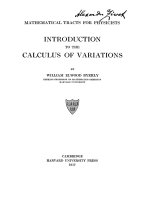Introduction to the Simplex Algorithm
Bạn đang xem bản rút gọn của tài liệu. Xem và tải ngay bản đầy đủ của tài liệu tại đây (219.45 KB, 68 trang )
ECE 307 – Techniques for Engineering
Decisions
Introduction to the Simplex Algorithm
George Gross
Department of Electrical and Computer Engineering
University of Illinois at Urbana-Champaign
ECE 307 © 2005 – 2009 George Gross, University of Illinois at Urbana-Champaign, All Rights Reserved.
1
SOLUTION OF SYSTEMS OF LINEAR
EQUATIONS
We examine the solution of
Ax = b
using Gauss─Jordan elimination
We first use a simple example and then
generalize to cases of general interest
Consider the system of two equations in five
unknowns:
ECE 307 © 2005 – 2009 George Gross, University of Illinois at Urbana-Champaign, All Rights Reserved.
2
SOLUTION OF SYSTEMS OF LINEAR
EQUATIONS
⎧
⎪
S1 ⎨
⎪
⎩
x1 − 2 x 2 + x 3 − 4 x 4 + 2 x 5 = 2
(i )
x1 − x 2 − x 3 − 3 x 4 − x 5 = 4
( ii )
For this simple example, the number of
unknowns exceeds the number of equations and
so the system has multiple solutions; this is the
principal reason that the LP solution is nontrivial
ECE 307 © 2005 – 2009 George Gross, University of Illinois at Urbana-Champaign, All Rights Reserved.
3
SOLUTION OF SYSTEMS OF LINEAR
EQUATIONS
The Gauss ― Jordan elimination uses elementary
row operations:
multiplication of any equation by a nonzero
constant
addition to any equation of a constant
multiple of any other equation
We transform S 1 into the set S 2 by multiplying
equation (i) by ─1 and adding it to equation (ii)
⎧⎪ x 1 − 2 x 2 + x 3 − 4 x 4 + 2 x 5 = 2
S2 ⎨
x2 − 2 x3 + x4 − 3 x5 = 2
⎪⎩
ECE 307 © 2005 – 2009 George Gross, University of Illinois at Urbana-Champaign, All Rights Reserved.
4
DEFINITIONS
A basic variable is a variable x i that appears with
the coefficient 1 in an equation and with the
coefficient 0 in all the other equations
The variables x j that are not basic are called
nonbasic variables
In the system S 2 , x 1 appears as a basic variable;
x 2 , x 3 , x 4 and x 5 are nonbasic variables
Basic variables may be generated through the
use of elementary row operations
ECE 307 © 2005 – 2009 George Gross, University of Illinois at Urbana-Champaign, All Rights Reserved.
5
DEFINITIONS
A pivot operation is the sequence of elementary row
operations that reduces a system of linear
equations into the form in which a specified
variable becomes a basic variable
A canonical system is a set of linear equations
obtained through pivot operations with the property
that the system has the same number of basic
variables as the number of equations in the set
ECE 307 © 2005 – 2009 George Gross, University of Illinois at Urbana-Champaign, All Rights Reserved.
6
CANONICAL SYSTEM FORM
We transform the system S 2 into the canonical
form of system S 3 :
⎧ x1 − 3x 3 − 2x 4 − 4x 5 = 6
⎪
S3 ⎨
⎪ x2 − 2x3 + x4 − 3x5 = 2
⎩
The basic solution is obtained from a canonical
system with all the nonbasic variables set to 0
For the example, we set x 3 = x 4 = x 5 = 0 and so
x 1 = 6 and x 2 = 2
ECE 307 © 2005 – 2009 George Gross, University of Illinois at Urbana-Champaign, All Rights Reserved.
7
BASIC FEASIBLE SOLUTION
A basic feasible solution is a basic solution in which
the values of all the basic variables are
nonnegative
In the example of system S 2 , we may choose any
two variables to be basic
In general for a system of m equations in n
⎛n⎞
unknowns there are ⎜ ⎟ possible combinations
⎝m⎠
of basic variables
ECE 307 © 2005 – 2009 George Gross, University of Illinois at Urbana-Champaign, All Rights Reserved.
8
BASIC FEASIBLE SOLUTION
As n increases the number of combinations
becomes large even though it is finite
For the example, we have
⎛ 5⎞
5!
= 10
⎜ ⎟ =
3! 2!
⎝ 2⎠
combinations of possible choices
ECE 307 © 2005 – 2009 George Gross, University of Illinois at Urbana-Champaign, All Rights Reserved.
9
THE SIMPLEX SOLUTION METHOD
We next use a simple example to construct the
simplex solution method
The simplex method is a systematic and efficient way
of examining a subset of the basic feasible solutions of the LP to hone in on an optimal solution
We apply the notions introduced in the definitions
we introduced above
ECE 307 © 2005 – 2009 George Gross, University of Illinois at Urbana-Champaign, All Rights Reserved.
10
SIMPLEX METHODOLOGY EXAMPLE
max Z = 5 x 1 + 2 x 2 + 3 x 3 − x 4 + x 5
s .t .
canonical
form
⎧
⎪
⎪
⎨
⎪
⎪⎩
x 1 + 2x 2 + 2x 3 + x 4
3x 1 + 4x 2 +
xi ≥ 0
x3
+ x5
= 8
(*)
= 7
(**)
i = 1, … , 5
ECE 307 © 2005 – 2009 George Gross, University of Illinois at Urbana-Champaign, All Rights Reserved.
11
THE SIMPLEX SOLUTION METHOD
The canonical form of the example allows the
determination of a basic feasible solution
x1 = x 2 = x 3 =
0
x4 =
8,
x5 =
7
The corresponding value of the objective is
Z = − 8 + 7 = −1
The next step is to improve the basic feasible
solution by finding an adjacent basic feasible
solution
ECE 307 © 2005 – 2009 George Gross, University of Illinois at Urbana-Champaign, All Rights Reserved.
12
ADJACENT FEASIBLE SOLUTION
An adjacent feasible solution is one which differs
from the current basic feasible solution in exactly
one basic variable
Note, we characterize a basic feasible solution by the
following traits
basic
variable ≥ 0
nonbasic variable = 0
ECE 307 © 2005 – 2009 George Gross, University of Illinois at Urbana-Champaign, All Rights Reserved.
13
ADJACENT FEASIBLE SOLUTION
The search for an adjacent basic feasible solution
uses the idea of making a nonbasic variable into a
basic variable by increasing its value from 0 to the
largest positive value without violating any
constraints
To make the search efficient, we choose the
nonbasic variable that can improve the value of Z
by the largest amount
ECE 307 © 2005 – 2009 George Gross, University of Illinois at Urbana-Champaign, All Rights Reserved.
14
ADJACENT FEASIBLE SOLUTION
In the example, consider the nonbasic variable
x 1 , we leave x 2 = x 3 = 0 and examine the
possibility of making x 1 into a basic variable
The variable x 1 enters in both constraints
x1 + x4
3x 1 +
= 8
x5
= 7
ECE 307 © 2005 – 2009 George Gross, University of Illinois at Urbana-Champaign, All Rights Reserved.
15
ADJACENT FEASIBLE SOLUTION
The largest value x 1 can assume without making
either x 4 or x 5 negative is
min
⎧
⎨8,
⎩
7⎫
7
⎬ =
3⎭
3
We have the new basic variable with the value
x1 =
7
3
,
and the other basic variable is
17
x4 =
3
ECE 307 © 2005 – 2009 George Gross, University of Illinois at Urbana-Champaign, All Rights Reserved.
16
ADJACENT FEASIBLE SOLUTION
and the three nonbasic variables are set to 0:
x 2 = x 3 = 0 and x 5 = 0
Note that we have an improvement in Z since its
value becomes
Z = 5
i
7 17
18
−
=
= 6 > −1
3
3
3
We next need to put the system of equations into
canonical form:
ECE 307 © 2005 – 2009 George Gross, University of Illinois at Urbana-Champaign, All Rights Reserved.
17
SIMPLEX METHODOLOGY EXAMPLE
max Z = 5 x 1 + 2 x 2 + 3 x 3 − x 4 + x 5
s .t .
non canonical
form
for x1
⎧
⎪
⎪
⎨
⎪
⎪⎩
x 1 + 2x 2 + 2x 3 + x 4
3x 1 + 4x 2 + x 3
xi ≥ 0
+ x5
= 8
(*)
= 7
(**)
i = 1, … , 5
ECE 307 © 2005 – 2009 George Gross, University of Illinois at Urbana-Champaign, All Rights Reserved.
18
ADJACENT FEASIBLE SOLUTION
1
(**)
multiply equation
by −
and add to
3
equation (*)
2x + 5x +
1
17
x4 − x 5 =
2
3
3
3
3
3
1
(**)
multiply equation
by
3
1
x1+ x 2 + x 3
3
3
4
1
7
+ x5 =
3
3
ECE 307 © 2005 – 2009 George Gross, University of Illinois at Urbana-Champaign, All Rights Reserved.
19
THE SIMPLEX SOLUTION METHOD
We continue this process until the condition of
optimality is satisfied:
in a maximization problem, a basic feasible
solution is optimal if and only if the relative
profits of each nonbasic variable is ≤ 0
in a minimization problem, a basic feasible
solution is optimal if and only if the relative
costs of each nonbasic variable is ≥ 0
ECE 307 © 2005 – 2009 George Gross, University of Illinois at Urbana-Champaign, All Rights Reserved.
20
THE SIMPLEX SOLUTION METHOD
The relative profits (costs) are given by the
change in Z corresponding to a unit change in a
nonbasic variable
We use this fact to select the next nonbasic variable
to enter the basis
ECE 307 © 2005 – 2009 George Gross, University of Illinois at Urbana-Champaign, All Rights Reserved.
21
SIMPLEX ALGORITHM FOR
MAXIMIZATION
Step 1:
start with an initial basic feasible
solution with all constraint equations in
canonical form
Step 2:
check for optimality condition: if the
relative profits are < 0 for each nonbasic
variable, then the basic feasible solution is
optimal and stop; else, go to Step 3
ECE 307 © 2005 – 2009 George Gross, University of Illinois at Urbana-Champaign, All Rights Reserved.
22
SIMPLEX ALGORITHM FOR
MAXIMIZATION
Step 3:
select a nonbasic variable to become the new
basic variable; check the limits on the
nonbasic variable – the limiting constraint
determines the basic variable that is being
replaced by the selected nonbasic variable
Step 4:
determine the canonical form for the new
set of basic variables through elementary
row operations; compute the basic feasible
solution, Z and return to Step 2
ECE 307 © 2005 – 2009 George Gross, University of Illinois at Urbana-Champaign, All Rights Reserved.
23
THE SIMPLEX TABLEAU
We use an efficient way to represent visually the
steps in the simplex method through a sequence
of so-called tableaus
We illustrate the tableau for the simple example
for the initial basic feasible solution
ECE 307 © 2005 – 2009 George Gross, University of Illinois at Urbana-Champaign, All Rights Reserved.
24
THE SIMPLEX TABLEAU
coefficients of the
basic variables in Z
cj
coefficient of x j in Z
5
2
3
–1
1
x5
cB
basic
variables
x1
x2
x3
x4
–1
x4
1
2
2
1
1
x5
3
4
1
constraint
constants
8
1
7
ECE 307 © 2005 – 2009 George Gross, University of Illinois at Urbana-Champaign, All Rights Reserved.
25









